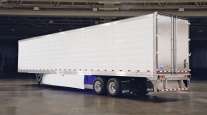Senior Reporter
Strick to Add Its Own Features to Trailers to Comply With Phase 2 GHG Mandates

This story appears in the June 19 print edition of Transport Topics.
FORT WAYNE, Ind. — Strick Trailers will begin offering trailers that it has loaded with features that comply with Phase 2 greenhouse gas mandates intended to make trailers more fuel-efficient.
Because the rule applies only to trailers built after Jan. 1, Sass also said that might lead some carriers into refurbishing trailers to avoid making the changes.
“What you will have from us in two years or less is an aerodynamic trailer with little or no add-ons. That’s our plan,” Strick President Steve Burns told Transport Topics.
Strick’s features are designed to be part of the trailer, “so you don’t have all of these pieces that fall off and get broken,” Burns said during the company’s 80th anniversary celebration here June 6-8. The event included a symposium and tour of its plant in nearby Monroe.
The company voluntarily took this step. “It is something that we have worked on, developed and continue to work on,” Burns said, but he did not discuss what types of features are under development.
Side skirts are popular aerodynamic devices, and other trailer makers already make and install their own.
“We have offered our own side skirt since 2010 and have continued to update with improvements since then,” said Larry Roland, director of marketing at Utility Trailer Manufacturing Co.
Hyundai Translead also makes its own skirts, said Chief Sales Officer Glenn Harney. “I am not aware of any other products we are looking at,” Harney said.
Other manufacturers said they rely on suppliers to provide aerodynamic features.
“We have partnered with our aero suppliers and customers to offer a variety of solutions. We plan on continuing to work with them going forward to offer the best solutions available,” said David Gilliland, vice president of national accounts at Great Dane Trailers.
While at Stoughton Trailers there are no immediate plans to vertically integrate these devices, said David Giesen, vice president of sales at the manufacturer.
“Our approach has been to rely on the suppliers to test best designs and be the experts in this field,” he said. “We also want to give our customers exactly what they want, and many have very clear choices on industry offerings. This would differ if we had our own products that we were pushing.”
EPA and NHTSA estimate that the standards will reduce carbon dioxide emissions by about 1.1 billion metric tons.
Meanwhile, the Truck Trailers Manufacturing Association in January challenged in court Phase 2 Section IV, which applies to trailers — seeking to eliminate it.
Under the section, trailer production would be regulated in four stages: 2018, 2021, 2024 and 2027 and marks the first time trailers have fallen under EPA jurisdiction.
Trailer makers have a range of options for complying with Phase 2, EPA said. They include lower rolling- resistance tires and either a tire pressure monitoring system or an automatic tire inflation system, weight reduction or other “off-cycle technology.” EPA said, depending on the trailer type and model year.
However, perhaps bigger is better for achieving Phase 2 goals, Matt Sass, president of Fleet Trailer, suggested.
“Adding weight, adding length is a much more efficient way of trying to reduce greenhouse gas emissions than putting skirting on. With fewer trips, you are going to save a lot more GHG emissions,” Sass said during the tour of the Strick plant. The Castle Rock, Colo.-based company is a Strick dealership.
Because the rule applies only to trailers built after Jan. 1, Sass also said that might lead some carriers into refurbishing trailers to avoid making the changes.




